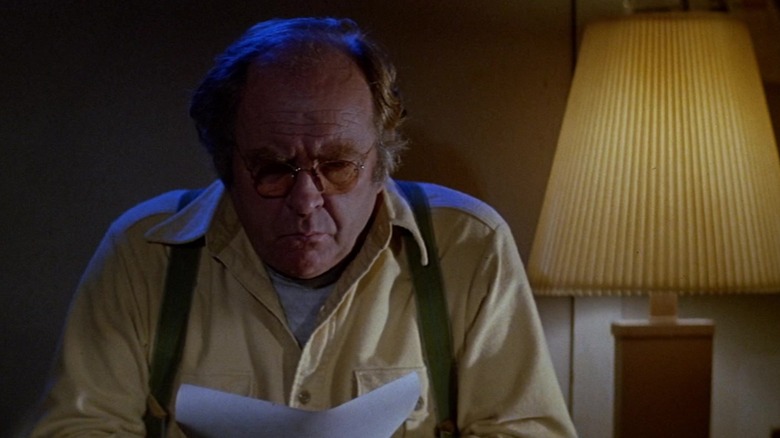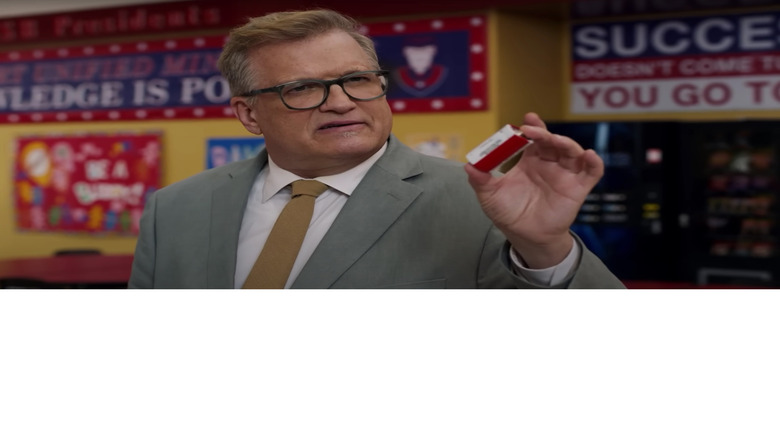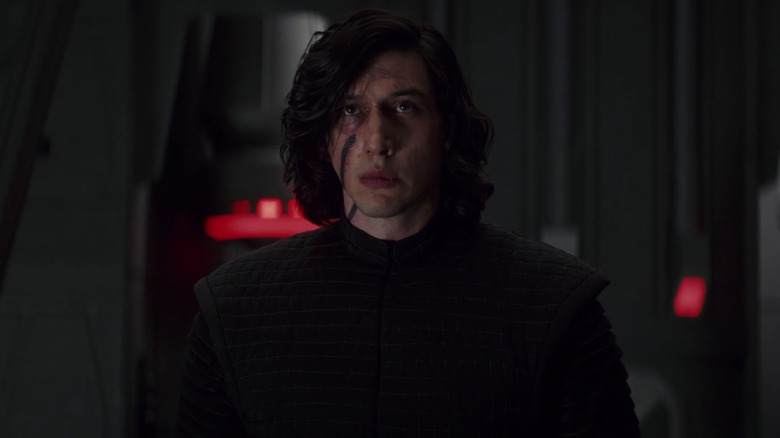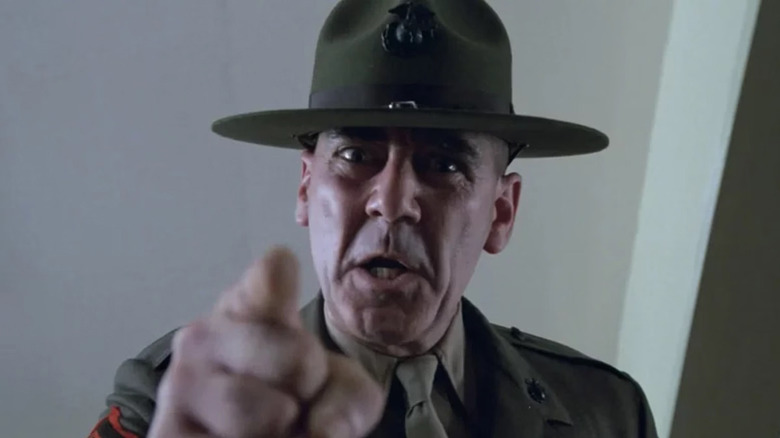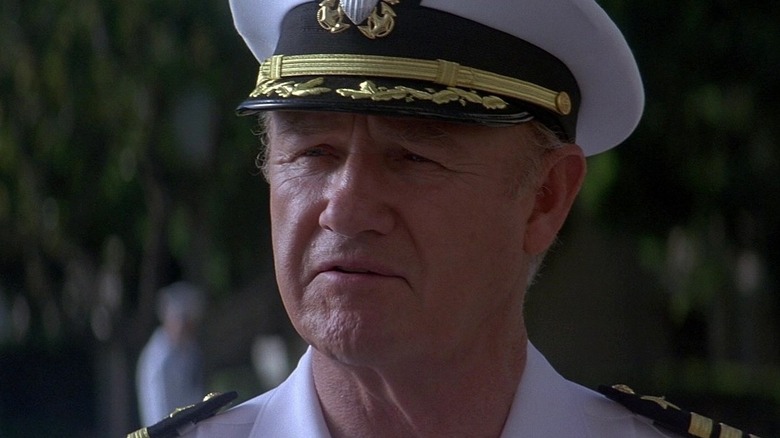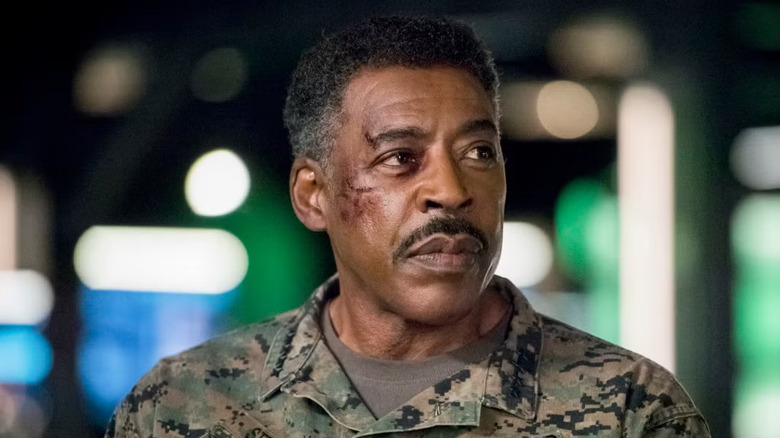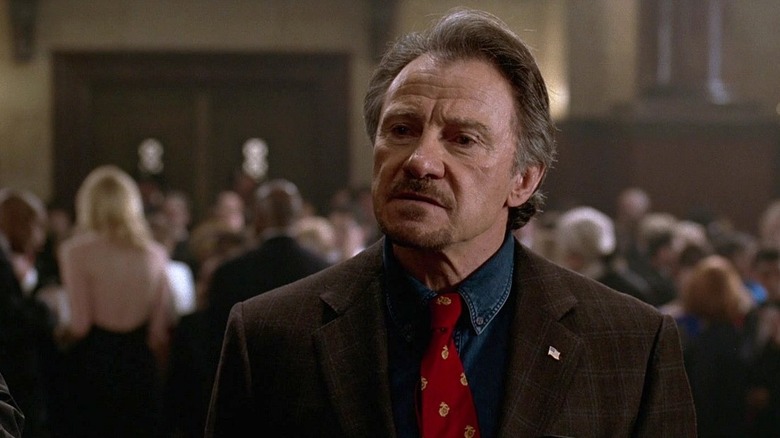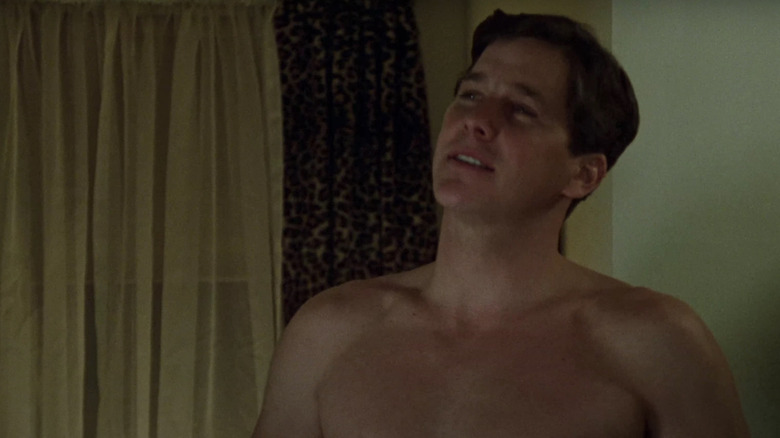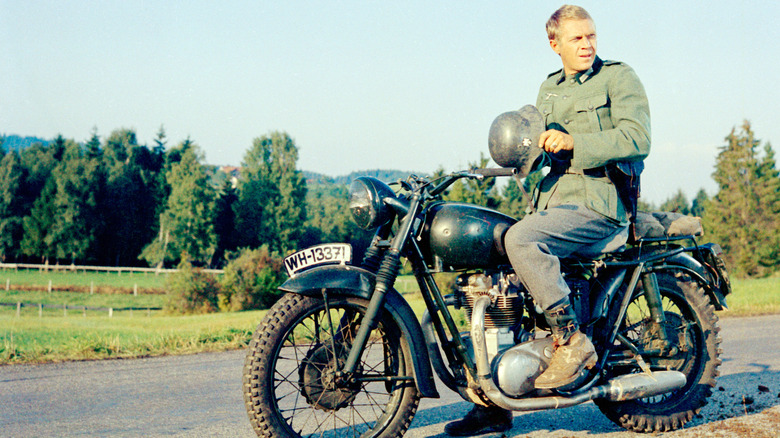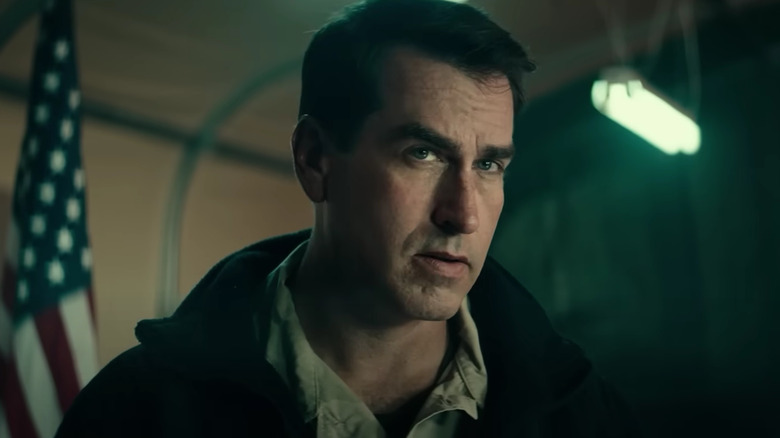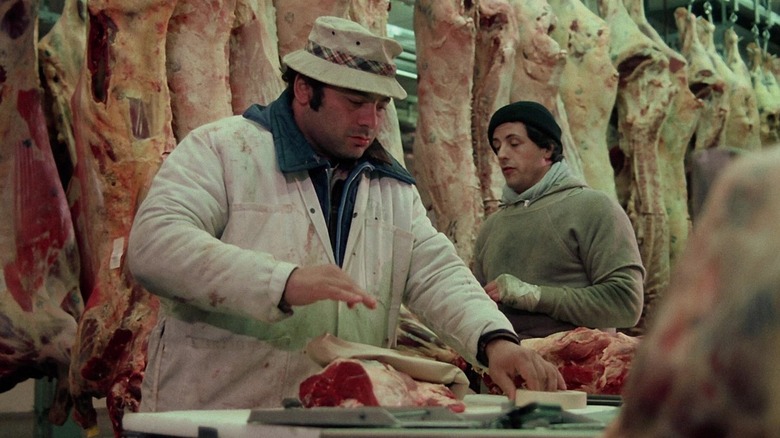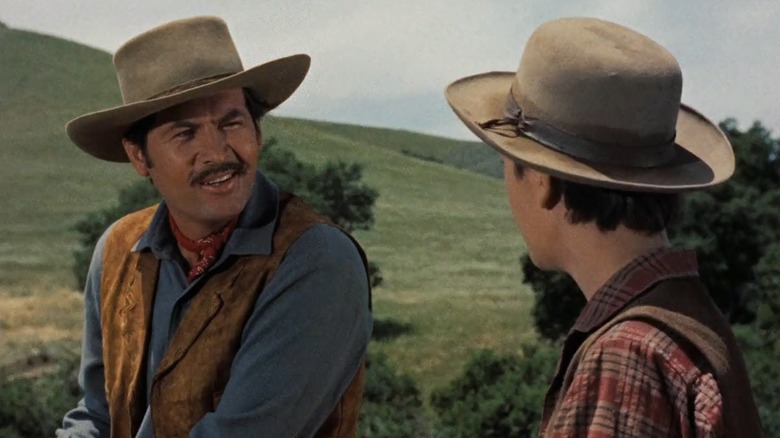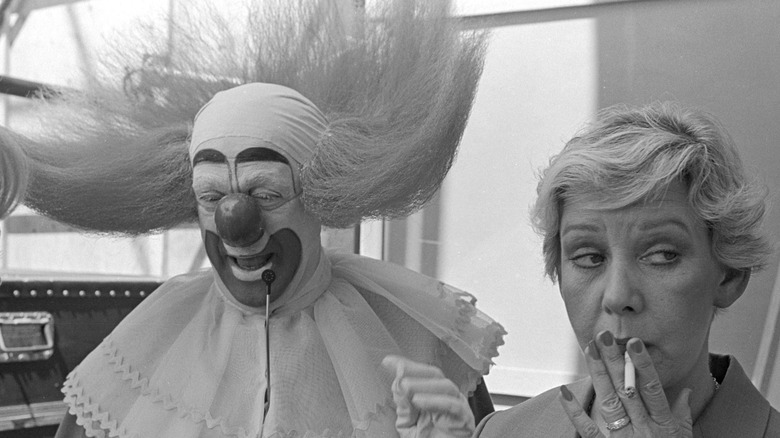Real-Life Retired Marines Who Became Actors
In theory, actors and United States Marines might seem to be the extreme opposites of one another. The latter are perceived to be among the toughest of the tough in the armed forces, able to take anything life throws at them, while the former have to be sensitive and in touch with their feelings in order to empathize with a variety of different characters they might play. Perhaps counterintuitively, then, it turns out that many actors we revere and acclaim actually served as Marines before becoming stars.
Not everyone on this list will surprise you. In fact, some are so absolutely obvious that you probably intuitively knew it even if you didn't literally know it for a fact. Others, however, so ably step into the shoes of characters who are so totally not "the few, the proud, the brave" that you'll wonder how they managed to turn their sensitivity off in order to survive boot camp. It's not just a generational thing, either — one might be inclined to think that old Hollywood, with its more macho aesthetic, was a friendlier space for military men, yet the battlefield-to-soundstage pipeline continues, even in our era of more complex notions of masculinity.
Here are some of the most notable former, real-life Marines who became actors in film and television.
Wilford Brimley
Wilford Brimley is most famous in pop culture for pitching oatmeal, warning of the dangerous of diabetes, and looking uncharacteristically old as a grandfather in Ron Howard's "Cocoon" when he was only 50. Don't let the folksy demeanor fool you — he served three years in the Marines, beginning in 1953, stationed in the Aleutians, ultimately receiving an honorable discharge as a Sergeant. Afterward, he put those military skills to use as a bodyguard, blacksmith, cattle wrangler and horse trainer. That last job got him work in the movie industry, where his friend Robert Duvall ultimately helped him get in front of the camera.
In addition to "Cocoon," classics in Brimley's filmography include the original "True Grit," "The China Syndrome," "The Natural," and John Carpenter's "The Thing." For his final role, he played a pastor in the 2017 faith-based movie "I Believe." Though he died in 2020, these days, he lives on as a popular meme, The Brimley-Cocoon Line, which measures how good modern celebrities look when they hit the age Brimley was (50 years, 9 months, and 6 days) when that film hit theaters. Most look surprisingly younger, but few lived the tough-guy lifestyle with a lack of personal vanity to the degree that Brimley did before he reached middle age. He earned those gray hairs.
Drew Carey
If you didn't know Drew Carey was a former Marine, you might have missed the haircut he had for most of his career, a holdover from his time in the service. Carey joined the Marine Corps reserve after dropping out of college and seeing no other immediate job prospects. He served for six years, working primarily as a radio operator, from 1980-1986, reaching the rank of Sergeant but never facing combat. While in the military, he began writing jokes, and once claimed that if his comedy career hadn't taken off, he'd probably still be in the military. As a comedian, he retained the regulation buzzcut and glasses he had worn while first honing his persona, and when he moved into acting, his roles were mostly based on his stand-up persona, allowing him to keep the look.
Carey is best known for starring in his eponymous sitcom, emceeing and performing in the U.S. version of the improvised comedy show "Whose Line Is It Anyway," and later hosting game shows like "The Price Is Right." He's also an active Libertarian, occasionally hosting videos for Reason magazine, and advocating his views on talk shows like "Real Time With Bill Maher." More recently, he finally let his hair grow longer, and proved to be a true Hollywood hero by picking up the meal tabs for striking writers.
Adam Driver
In the "Star Wars" sequel trilogy, Adam Driver insisted on doing as many of his own stunts as possible, because he could. As a former Marine, he'd been through worse. Motivated by the 9-11 attacks, Driver enlisted at age 18 and served in Weapons Company, 1st Battalion, 1st Marine Regiment, 1st Marine Division at Camp Pendleton, California, operating the 81mm mortar, which is significantly more deadly than a lightsaber. After two years and eight months, having obtained the rank of lance corporal, he received a medical discharge following a mountain biking accident.
Unlike fellow actor Tom Cruise, however, whose similar love of doing his own stunts has driven him almost exclusively to action movies in recent years, Driver tends toward more introspective roles, in movies like Martin Scorsese's "Silence," Jim Jarmusch's "Paterson," or Noah Baumbach's "Marriage Story" (all among the 15 best Adam Driver movies that we ranked.) Still, he sees parallels between acting and military service, in that they both involve being part of a team in service of a larger goal. With that in mind, he founded Arts in the Armed Forces, a nonprofit providing free theater and film programming to active-duty service members. Sadly, it was dissolved in 2023.
R. Lee Ermey
For some of the actors on this list, you might never know they had a military background if they didn't tell you. For many, their acting talents might appear to have little to do with their active service. Such is not the case with R. Lee Ermey, who is probably more identified with the Marines than any other actor.
Ermey joined the Marines after a series of juvenile offenses caused a judge to give him the option of either service or jail. He initially opted for the Navy, but they wouldn't take anyone with his record. It turned out, however, that life on a farm with a hard-driving father prepared him perfectly for the Marine Corps. Ermey would spend 11 years there, with 14 months in Vietnam and two tours in Okinawa. He retired a Staff Sergeant in 1971, running a few bars until he heard Hollywood was looking for military advisors.
Adopting what he called an infiltration strategy, he would get himself hired as a technical advisor, then prove to the filmmakers that he was good enough to cast in the movie itself. This most famously worked with Stanley Kubrick on "Full Metal Jacket," who had to be convinced Ermey could be mean enough. Once Kubrick saw him improvise, the director transcribed Ermey's best lines and added them to the script.
That role of Gunnery Sergeant Hartman earned him a career of playing authority figure roles, and in 2002, the Corps' first post-service promotion to honorary Gunnery Sergeant.
Gene Hackman
Before playing criminal mastermind Lex Luthor opposite Christopher Reeve's Superman, Gene Hackman was outsmarting communists in the Marines during the 1940s. Lying about his age to enlist early at 16, Hackman served as a radio operator and broadcast journalist for the Corps from 1947-1952. Stationed in China initially, Hackman was tasked with destroying captured Japanese equipment, so China couldn't use it in their favor. Later, he was active in repatriating many Japanese and Korean refugees left in China after World War II.
Hackman frequently portrayed smart guys and tough guys, notably Popeye Doyle in the "French Connection" movies, the mastermind of David Mamet's "Heist," and Reverend Scott in "The Poseidon Adventure," among many other memorable roles. He also implicitly critiqued some right-wing, hawkish military excesses in some of his roles, notably as the warmongering submarine commander in "Crimson Tide," and a homophobic senator and mismatched in-law in "The Birdcage." Hackman's final role was as an ex-President running for mayor in a small town in Donald Petrie's "Welcome to Mooseport" in 2004, after which he disappeared from Hollywood, citing the stress. As of this writing, 20 years later, he remains retired, writing novels but still alive in his mid-90s.
Ernie Hudson
Ernie Hudson's Marines career was not long. Though he joined right out of high school, he was dismissed three months later due to asthma, after which he moved to Detroit to become a playwright. From there, he went to Wayne State University to develop his acting and writing skills. Later, he would leave the doctoral program at the University of Minnesota and the MFA program at Yale in order to take some prime roles. His biggest claim to fame remains his role as Winston Zeddemore in the "Ghostbusters" franchise, as the only member of the team not to be played by a previously established comedian (though Eddie Murphy was originally envisioned for the role).
While he has played military roles on TV shows like "Arrow" and "Twin Peaks," and cop roles in movies like "The Crow," Hudson's diverse acting career has followed a trajectory similar to Winston's in "Ghostbusters": If there's money in it, he'll believe whatever you say — and make audiences believe it too.
Harvey Keitel
Kicked out of his New York high school for chronic truancy, Harvey Keitel joined the Marines instead, serving in Lebanon as part of the anti-communist Operation Blue Bat for three years. While he earned a medal as a fire team leader, he never exceeded the rank of Private, but he did learn to deal with his fear of the dark. When it comes to commonalities between acting and the Marines, he sees the necessity for proper training in both.
After discharge, he made a living as a court stenographer for over a decade while studying acting, hitting the jackpot when he successfully auditioned for the lead role in Martin Scorsese's first film, "Who's That Knocking at My Door." It was the start of a long and productive partnership, with the actor regularly playing tough guys — including Judas in "The Last Temptation of Christ" — in the director's studies of toxic masculinity.
Ironically, Keitel's accurate knowledge of the military may have cost him a significant part that got away. Initially cast as Captain Willard in Francis Ford Coppola's Vietnam War epic "Apocalypse Now," he was fired and replaced by Martin Sheen for not playing the character passively enough.
Tim Matheson
Matheson was actually an actor first, as his successful teen acting career included the Lucille Ball movie "Yours, Mine and Ours" and the voice of young animated adventurer Jonny Quest. At the end of "Yours, Mine and Ours," his character joins the Marine Corps, and the year it was released, Matheson did as well, due to the Vietnam draft. The day he was set to film his character's physical in the movie was also the day of his draft physical. Though he became a squad leader in boot camp, he turned down officer training in order to go back to acting, though he remained in the Reserves for a couple more years.
Initially appearing mostly in westerns (though not any of the best westerns of all time), he transitioned into comedy with the success of "National Lampoon's Animal House" and then into directing TV movies and comedies. After a failed marriage, he moved to Los Angeles to pursue acting more full-time, and he scored the role of Dr. Brick Breeland on "Hart of Dixie," which led to a string of more medical roles.
Though he's not known for military roles, he did direct and act in the direct-to-video Navy SEAL actioner "Behind Enemy Lines: Colombia" for WWE Studios, costarring Joe Manganiello and wrestler Mr. Kennedy, along with Keith David and Steven Bauer.
Steve McQueen
Prior to joining the Marines, Steve McQueen — the late American actor, not the current British director — was in a street gang, stole hubcaps, attended a private school for troubled youth, and worked at a carnival and a brothel. Following an arrest for vagrancy, he also served 30 days on a chain gang. It's fair to say the Marines straightened him out...eventually. First, he was demoted from private first class five times, and spent time in the brig. After saving five fellow Marines from drowning in ice during a training exercise, however, the discipline began to take. Three years later, he was honorable discharged, following stints as a tank driver, mechanic, and honor guard protecting president Harry Truman's yacht. He got into acting thereafter thanks to the G.I. Bill.
Though he did many of his own stunts, McQueen didn't have the leeway that Adam Driver or Tom Cruise gets today, with his friend and stuntman Bud Ekins responsible for most of the famous driving in "Bullitt," and that motorcycle jump in "The Great Escape." McQueen's love of vehicles would carry over into his passion project "Le Mans." He succeeded in doing his own stunts for "The Towering Inferno," reigniting a rivalry with Paul Newman, after which he took a hiatus from acting to focus on motorcycle racing.
McQueen died at age 50 of mesothelioma, which he suspected it began during his Marines service when he removed asbestos insulation from a troop ship in the course of his duties.
Rob Riggle
Known for playing a dubious pseudo-journalist on "The Daily Show," and subsequently all sorts of comedic blowhards in movie roles, Rob Riggle came by his journalistic and authoritative chops authentically in the Marine Corps, where he served, mostly as a public affairs officer, for 23 years, including during his time at "The Daily Show." He intended initially to be a naval aviator, but after many delays, he opted for a less intensive schedule that would also allow him to pursue acting and comedy. In 2000, after 10 years of active duty, he transferred to the reserves, volunteering to go back on active duty after the 9-11 attacks. In 2004, he took a tactical pause, and joined the cast of "Saturday Night Live." In 2013, he formally retired from the Corps.
Riggle's acting career frequently sees him in absurd, deadpan roles in big comedies like "Step Brothers" and "21 Jump Street," though he also has a successful voice-over career in animated features like "The Lorax," "Hotel Transylvania," and "The Emoji Movie." He has compared acting to military service in that, for both occupations, there is never time to relax, because everything is a competition.
Burt Young
Burt Young, real name Gerald Tommaso DeLouise, is best known as Rocky Balboa's schlubby brother-in-law Paulie. In actuality, Young probably could have knocked out Sylvester Stallone, as he was a boxer in the Marine Corps, winning 32 of 34 fights, followed by 14 victories as a professional middleweight.
Young lied about his age to enlist at 16, after being booted out of private school, serving from 1957-1959. Though he never ranked higher than Private, his dedication to boxing would later earn him an exhibition match with Muhammad Ali, and his training methods would feature in the "Rocky" movies (check out our ranking of all nine movies over here), although he was always quick to note that punching sides of frozen beef was not one of them. He transitioned into acting while trying to impress a girlfriend and get her into the Lee Strasberg school, where Young ended up training with Strasberg for two years.
It paid off to the tune of over 160 movie roles, often as tough guys, bodyguards, and crooks, in classics like "Once Upon a Time in America," "Chinatown," and "Back to School." His most notable role as a Marine, however, came in the TV series "Roomies," in which he played a retired drill instructor who decides to finally go to college.
Fess Parker
Naturally, TV's Davy Crockett and Daniel Boone was a former Marine, having been turned down from the Navy for the most badass of reasons — he was too tall to fit in their planes! They transferred him to the Marine Corps as a radio operator. He served in the Pacific during World War II, where he came close to being selected for Iwo Jima. When it came to acting, size proved a determining factor as well; after a director told him he was also too tall for the stage, he opted for the big screen, where he soon became a Warner Bros. contract player. It was his role in the WB giant ant flick "Them!" that caught Walt Disney's eye, and Parker became Davy Crockett. It was a role that made him iconic but also typecast, and he left Disney after refusing a small role in "Tonka."
He became a Paramount player after that, though he would return to coonskin-capped frontiersmen as star, coproducer, and occasional director of "Daniel Boone," for a successful six-year run. After acting, he opened a winery that remains open as of this writing.
Disney formally named him a Legend in 1991. In addition to his iconic Crockett role, he also starred in "Old Yeller," the company's movie about a beloved pet turned rabid that has been traumatizing children and animal lovers ever since 1957.
Bob Bell
The next time you think of calling someone a bozo, maybe keep in mind the fact that the most popular Bozo the Clown performer, Bob Bell, was a veteran of both the Marines and the Navy, and he could probably easily whip your butt. Despite lack of vision in his right eye, Bell memorized the eye charts in order to pass the military physical in 1941. When the Marines figured it out, they gave him a medical discharge less than a year into his service; he promptly joined the Navy instead, though his disability kept him from combat.
Bell didn't create the Bozo character, as that honor falls to Capitol Records' Alan W. Livingston, who came up with him for a series of children's storybook read-along albums. However, after actor Larry Harmon bought the rights to the character and sold him into local syndication, Bell played the famous clown in the Chicago market, where he made "The Bozo Show" the most popular locally produced children's show in the history of TV, with a 10-year waiting list for tickets at the height of its popularity. Featuring games, comedy sketches, cartoons, and product placement (before it was banned from shows for children), "The Bozo Show" may have set the template for Krusty the Clown on "The Simpsons," with Bell's voice directly inspiring Dan Castellaneta's performance.
In October 2021, longtime Bob Bell fan David Arquette purchased the rights to Bozo.

